The need for energy conservation has assumed paramount importance in the textile industry with the rising energy cost on the one hand and the severe energy shortage on the other. Textile mills, particularly in the South, have suffered in the last few years due to severe power shortage resulting in greater resort made to captive power through gensets, which has increased the power cost drastically. This has also contributed to generating greater awareness on finding ways to save energy costs and making the whole manufacturing process more efficient. The energy cost, next to the material cost, is around 15-20 per cent of the total production cost.
Apart from the power cost, manpower shortage is yet another major problem forcing the mills to deploy more automated machines. Hence, with textile machinery manufacturers integrating automation in the machines they produce, the power requirements of mills keep rising.
As manufacturers face an increasingly competitive global business environment, they seek opportunities to reduce production costs without negatively affecting product yield or quality. Rising energy prices are driving up costs and decreasing value added at the plant. Successful, cost-effective investment into energy-efficiency technologies and practices meets the challenge of product quality maintenance despite reduced production costs. This is especially important in the current age, as energy-efficient technologies often include “additional” benefits such as increasing the productivity of the company or reducing the water and/or materials consumption.
There are different energy-efficiency systems in general use. However, even the different cost-effective options often are not preferred in textile plants in view of the fact that majority of them are run by SMEs with limited resources and knowledge about their working.
The Textile Magazine has been emphasising the importance of conservation of natural resources as well as their judicious utilisation, and this issue focuses on the energy conservation practices followed by leading textile industries to reduce the production cost and thereby save energy.
Alok Industries
Alok Industries, a leading vertically integrated textile manufacturing company, has been continually working on energy conservation 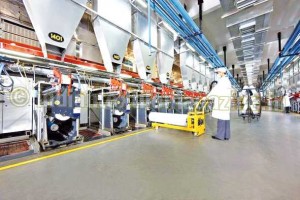 through improved operational and maintenance practices. In line with its commitment to conservation of natural resources, all its units continue making efficient use of energy.
through improved operational and maintenance practices. In line with its commitment to conservation of natural resources, all its units continue making efficient use of energy.
The company replaced illuminating devices with energy-efficient ones and ensured optimal utilization of the equipments. It also ensured full suction pressure using the OHTC dust collection system in the ring frame, speed frame, link coner areas and the TFO machines in spinning plants.
Special measures were also taken by the company to reduce the load on air-conditioning plants. Diesel and gas consumption was reduced by stopping heat tracing of furnace oil lines from the fuel plant to the DG set, availing GEB power and commissioning of coal boilers. Heat recovery systems were installed to recover the heat from CRP hot water to the boiler feed.
Further, Alok has installed an EMS energy monitoring system for greater accuracy of energy consumption reports for utility departments and process machines. The utility boiler has been converted from furnace oil to PNG, ensuring a dual firing system.
The company has also installed the caustic handling system on its process machines. In order to maintain the temperature of the chiller plant, the pipelines have been redesigned. The plants have now been equipped with water-cooled air-conditioning systems, so that less energy is consumed. Further, the stenter machines are being automated to save power, while closed circuits and timer circuits have been installed to avoid water wastage.
In addition, the awareness programs regularly conducted among the company staff and workers on energy conservation, rain water harvesting and on reducing domestic water consumption have yielded results. The new air dampers in the air-conditioning systems guarantee favourable ambience at night. The plant now operates more on fresh air resulting from energy saving.
Special humidity sensors introduced in air-conditioning system help control the air washer units so as to automatically stop the air washer pump during the rainy season. Again, sun control films and sun blinds are being fixed on window glasses to reduce the load on the air-conditioning system. The wind turbines already installed help minimize the use of ceiling and exhaust fans.
The Alok management is now making additional efforts for planting thousands of trees all around the campus in order to regulate temperature and maintain the ground water level.
Sutlej Textiles
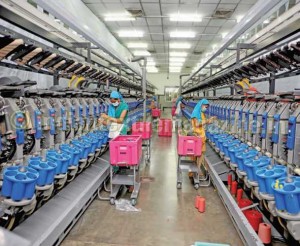 Sutlej Textiles and Industries Ltd., the flagship of the K.K. Birla Group, has given due importance to energy efficiency by making process and machinery modifications, efficient energy audit, waste heat recovery, etc. The additional measures taken by the company further resulted in a cut in energy consumption and subsequently the cost of production.
Sutlej Textiles and Industries Ltd., the flagship of the K.K. Birla Group, has given due importance to energy efficiency by making process and machinery modifications, efficient energy audit, waste heat recovery, etc. The additional measures taken by the company further resulted in a cut in energy consumption and subsequently the cost of production.
In the Bhawanimandi unit, Sutlej has installed 48 new inverters which are capable of saving Rs. 39.09 lakhs per annum and proposes to install 38 more in the current year at a cost of Rs. 45 lakhs to obtain an annual saving of Rs. 16.63 lakhs. Old motors are being replaced with new energy-efficient ones on machines in different departments. Similarly, old pumps have been removed and new ones fixed.
Redesigning of compressed air line was done to stop air leakage. This helped attain an annual saving of 6,24,360 KWH worth Rs. 36.59 lakhs. The company proposes to change the pneumatic accessories at a cost of Rs. 10 lakhs to save Rs. 21.27 lakhs per annum. It was able to save 32,670 KWH per annum worth Rs. 1.91 lakhs by installing a heat exchanger.
Conversion of electrical to steam heating in a R.F. dryer resulted in an annual saving of 1,30,680 KWH worth Rs. 7.66 lakhs. In its 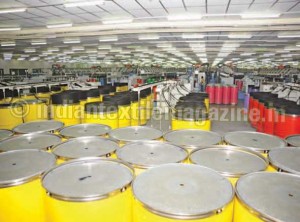 humidification plants, the company replaced 19 old fans by new energy-saving ones and was able to save 1,37,940 KWH valued at Rs. 8.08 lakhs. The company also proposes to install a condensation pump for steam at a capital cost of Rs. 8 lakhs for an expected annual saving of Rs. 5.32 lakhs.
humidification plants, the company replaced 19 old fans by new energy-saving ones and was able to save 1,37,940 KWH valued at Rs. 8.08 lakhs. The company also proposes to install a condensation pump for steam at a capital cost of Rs. 8 lakhs for an expected annual saving of Rs. 5.32 lakhs.
Sutlej Industries replaced six supply air fans at the humidity plants at the Kathua unit, resulting in an annual saving of 42,110 units. It now proposes to replace 53 fans to save 2,81,000 units per annum worth Rs. 9.45 lakhs.
By installing heat recovery systems in its dye houses, the company was able to save about Rs. 35 lakhs a year and plans to replace the old fan there in the current year to save 11,37,000 units worth Rs. 38.20 lakhs.
At its Bhilad unit, the company had installed a condensate recovery system in its process house which reduced fuel consumption by 600 tons per annum and was able to save Rs. 28 lakhs. It now plans to install the Luwa heat recovery system from waste water to reduce fuel consumption by 365 tons per annum which is expected to yield a saving of Rs. 17.03 lakhs in 2013-14. By automating its supply water pumps, the company was able to save 21,600 units per annum valued at Rs. 1.38 lakhs.
Sutlej had also installed close loop control systems on its compressors for efficient working to obtain an annual saving of 1,36,000 units worth Rs. 8.66 lakhs. Optimized utilization of its humidification plant reduced its energy consumption by 1,82,500 units and saved Rs. 11.63 lakhs per annum.
The company also proposes to install low and high pressure steam line separately to reduce fuel consumption by 600 tons per annum for an expected saving of Rs. 28 lakhs.
Grasim Industries
Grasim Industries Ltd. of the Aditya Birla Group, originally a textile manufacturer, has diversified successfully into VSF, chemicals and 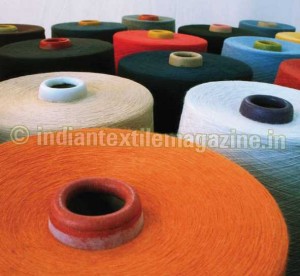 cement. In its viscose staple fibre and pulp units, the company has been constantly engaged in energy conservation through installation of an energy-efficient screw chiller in the place of the reciprocating type compressor in the viscose and CS2 refrigeration system.
cement. In its viscose staple fibre and pulp units, the company has been constantly engaged in energy conservation through installation of an energy-efficient screw chiller in the place of the reciprocating type compressor in the viscose and CS2 refrigeration system.
Backwashing of the rotary vacuum filter (RVF) has been carried out using RVF mother liquor instead of soft water. Conventional surface aerators have been replaced with energy-efficient surface aerators in the effluent treatment plant. The caustic dilution plant has been upgraded for reduced power consumption, and the viscose, spinning and auxiliary units provided with a low voltage transformer. A triple effect anhydrous evaporator has replaced the double-effect in the auxiliary unit.
In the chemical plant, the second generation electrolyser was recently converted into a fifth generation one and the inefficient ones were remembraned. A new screw compressor is being used now. In its textile unit, optimum humidification has been attained by using chillar plants, thereby saving power. TFO speeds have been duly increased.
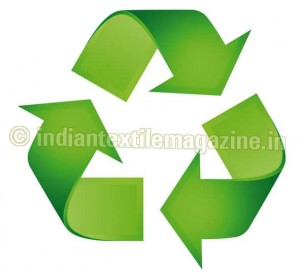 Grasim Industries has proposed to install a new caustic dilution plant in its viscose staple fibre and pulp units to save power. It plans to fix motorised valves for the TG3 cooling tower pump delivery line and a variable frequency drive for the product liquor flash tank pump in the evaporator to reduce power consumption. To replace the HP ejector system for the MSFE with LP ejector and a vacuum pump combination, the company proposes to install LED lights and replace the repeatedly burnt motors in the textile unit.
Grasim Industries has proposed to install a new caustic dilution plant in its viscose staple fibre and pulp units to save power. It plans to fix motorised valves for the TG3 cooling tower pump delivery line and a variable frequency drive for the product liquor flash tank pump in the evaporator to reduce power consumption. To replace the HP ejector system for the MSFE with LP ejector and a vacuum pump combination, the company proposes to install LED lights and replace the repeatedly burnt motors in the textile unit.
RSWM
RSWM Ltd., the flagship of the LNJ Bhilwara Group, primarily produces best quality 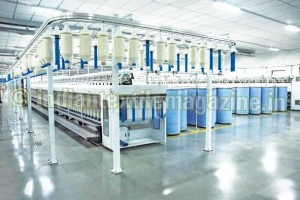 yarns like synthetic, blended, mélange, cotton, specialty yarns and value-added suiting and denim fabrics. The company is self-reliant in captive power generation that feeds its integrated units all across Rajasthan.
yarns like synthetic, blended, mélange, cotton, specialty yarns and value-added suiting and denim fabrics. The company is self-reliant in captive power generation that feeds its integrated units all across Rajasthan.
RSWM has taken several measures to conserve energy in all its departments. In the spinning unit, the company has installed VFD on all the 24 Chinese ring frames. It has reduced the load on its compressors by arresting air leakages at the blow room, carding, draw frame, ring frame and its autoconer machines for saving compressed air power, apart from reorganising air cleaning of machines.
A new ETP plant for dye house effluent treatment with zero discharge has been installed. The plant also reduces overall water consumption and water wastage. A 1100 kld RO plant has been installed in the humidification plant so that the purified water will lengthen the life of the plant and its ducts.
The company has also replaced the WCS system V-belts with cogged belts for power saving and longer belt life. The boiler fuel has been changed from steam coal to pet coke in order to reduce the production cost and the old pipelines of the dyeing machines replaced to prevent leakages.
In the fabric division, the APH tubes have been replaced and the ID fan duct insulated in the thermopac. About 500 kg of coal is saved every day by fine-tuning the coal feeding system, thereby bringing in additional annual revenue of Rs. 14 lakhs. Two pressure power pumps have installed for the hot water recovery system to save an annual Rs. 3 lakhs to the manufacturer.
In the VDR, an individual steam trapping system has been installed in the place of a combined trap system to effect a saving of 1.5 tonnes of steam per day leading to an annual saving of Rs. 5 lakhs.
By reducing the operating hours and by maintaining the ambient temperature of the humidification system the company is now able to get an additional annual revenue of Rs. 7 lakhs. The estimated overall saving with the adoption of these measures is expected to be Rs. 30 lakhs per annum.
In the RSWM denim division, the blowers of DO at the ETP plant are operated on an automatic mode resulting in a saving of 15 kwh per day. Inverters have been installed in speed frames, and the company optimised air balancing at the humidification plant of phase 1 and phase 2 to ensure a daily saving of about 29.5 kwh.
RSWM has also designed a few plans for energy conservation for the current year through automation of the fire hydrant, alarm and sprinkler systems. There are plans to increase the number of spindles from 576 to 624 in the existing ring frames with the addition of one section of 48 spindles by which the capacity will increase from 44,016 spindles to 47,200 spindles. This will yield a surplus of Rs. 42 lakhs in the current year.
An addition has been made of two compact attachments imported from Suessen of Germany for ring frames and one core attachment imported from Pinter of Spain for one of the machines. For more value-added products, apart from the existing specifications of Melange yarn, two slub attachments would be imported from Caipo and Amsler.
The company also plans to install a Schlafhorst Autoconer AC X-5 for balancing the increased production output and a Thies dyeing machine of 850 kg capacity. In order to reduce manpower requirement and to improve housekeeping, an automatic bale pressing system will be installed.
Further, RSWM has plans to install a high pressure R.O. plant to improve the heat recovery and replace a stenter machine to save 200 Kwh power per day. Replacement of the drying range to ensure a saving of six tonnes of steam or one tonne coal per day is also under consideration.
Garden Silk Mills
Garden Silk Mills Ltd. is known for its quality textile prints, fabrics and intermediates, through its brands Garden and Garden Vareli. In 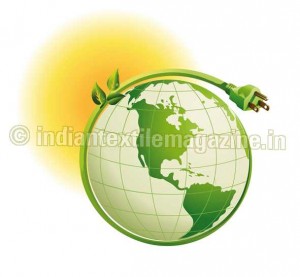 the field for over 30 years, the company continues to lay major emphasis on energy conservation. The efficiency of energy utilisation in each of its units is strictly monitored every quarter.
the field for over 30 years, the company continues to lay major emphasis on energy conservation. The efficiency of energy utilisation in each of its units is strictly monitored every quarter.
The water cooling stations of the company were inter-connected for optimized supply and reduced power consumption. HVAC sweating water was used in the cooling towers as make-up water, thereby reducing soft water consumption. There was a substantial power saving in compressed air by checking the system and line pressure drop.
The company also achieved a saving in air compressor by reducing the generation pressure by optimizing air pressure in the HP, MP and LP lines. The textile mill has installed a panel air-conditioner on draw warping machines at Vareli and thereafter increased the room temperature upto an average of two degrees Celsius, which has yielded a big saving of steam and power.
Garden Silk plans to install a third chipper at the CP 2 plant to reduce polymer waste generation and a process vapour fired VAM in the CP 4 and 5 plants to achieve energy efficiency. It also plans to install energy-efficient ID fans in the CP 4 and 5 coal thermic fluid heaters. The number of ends would then increase from 384 to 576 in POY and from 768 to 1,344 in FDY with the same number of positions, thereby increasing the yarn production and reducing the energy cost.
As a result of the above measures, both energy consumption and the cost of production would be minimised.
Ganesha Ecosphere
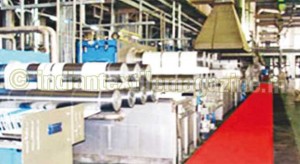 Energy efficiency continues to be a major area of focus at Ganesha Ecosphere Ltd. The company is keen on maximising energy conservation through improved operational and maintenance practices. In line with this, it is adopting new initiatives to succeed in its endeavour. The viscosity of fuel and other related parameters of the DG set have been optimised and at the thermopac boilers, air pre-heaters have been installed.
Energy efficiency continues to be a major area of focus at Ganesha Ecosphere Ltd. The company is keen on maximising energy conservation through improved operational and maintenance practices. In line with this, it is adopting new initiatives to succeed in its endeavour. The viscosity of fuel and other related parameters of the DG set have been optimised and at the thermopac boilers, air pre-heaters have been installed.
Energy-efficient pumps have replaced the small capacity cooling tower pumps. 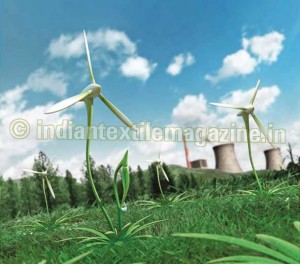 Regular maintenance and strict vigilance is being carried out by the management over energy use by regularly monitoring and educating the labour on the need for energy conservation.
Regular maintenance and strict vigilance is being carried out by the management over energy use by regularly monitoring and educating the labour on the need for energy conservation.
The energy conservation measures taken so far have helped the company check excess energy use consequent to the overall increase in production, and made it possible to cut production cost.
Soma Textiles
Soma Textiles, with a proven history of over 43 years and with its state-of-the-art manufacturing facilities, is one of the leading textile conglomerates in India.
In order to become energy efficient, the company has replaced the 11 KV, 2000 KVA low efficiency transformer by the high efficiency Crompton transformer. The utilization of drains and hot water of drying range cooling cylinders of Monforts finishing machine has resulted in a saving of a large quantity of soft water as well as steam. The conversion from the DC to AC variable frequency drive in the Hacoba warping machine ensures a big saving of power as well as production hike due to lesser downtime.
The management has carried out an air audit of the complete mill and has installed PNLDs at air dryers, resulting in saving of air and reduced losses.